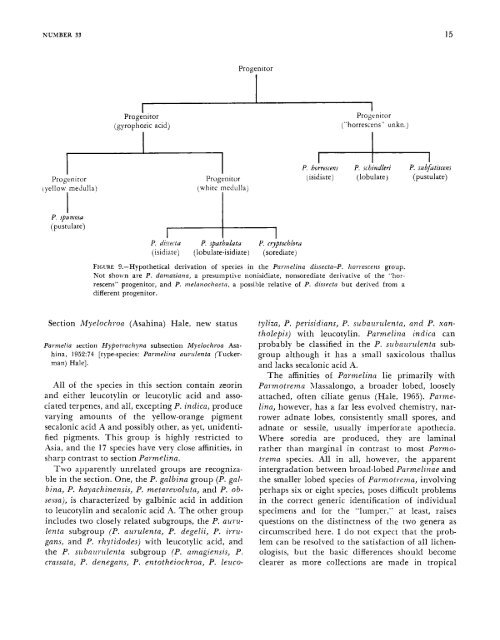A Monograph of the Lichen Genus Parmelina Hale - Smithsonian ...
A Monograph of the Lichen Genus Parmelina Hale - Smithsonian ...
A Monograph of the Lichen Genus Parmelina Hale - Smithsonian ...
Create successful ePaper yourself
Turn your PDF publications into a flip-book with our unique Google optimized e-Paper software.
NUMBER 33 15<br />
Progenitor<br />
I-<br />
Progenitor Progenitor<br />
(gyrophoric acid) (“horrescens” unkn.)<br />
P. horrescens IP. schindleri P. sirbfutiscens<br />
Progenitor ,(white Progenitor rnedullaj (isidiate) (lobulate) (pustulate)<br />
(yellow medulla)<br />
I P. spir ntosu<br />
(pustulate)<br />
r-l-l<br />
P. dissei.tu P. sputhulatu P. cryptochloru<br />
(isidiate) (lobulate-isidiate) (sorediate)<br />
FIGURE 9.-Hypo<strong>the</strong>tical derivation <strong>of</strong> species in <strong>the</strong> <strong>Parmelina</strong> dissecta-P. horrescens group.<br />
hrot shoivn are P. damaziana, a presumptile nonisidiate, nonsorediate derivative <strong>of</strong> <strong>the</strong> “hor-<br />
rescens” progenitor, and P. melanochaetn, a possible relative <strong>of</strong> P. dissecta but derived from a<br />
different progenitor.<br />
Section Myelochroa (Asahina) <strong>Hale</strong>, new status<br />
Parmelia section Hypotrachyna subsection Myelochroa Asa-<br />
hina, 1952374 [type-species: <strong>Parmelina</strong> aurdenta (Tucker-<br />
man) <strong>Hale</strong>].<br />
All <strong>of</strong> <strong>the</strong> species in this section contain zeorin<br />
and ei<strong>the</strong>r leucotylin or leucotylic acid and asso-<br />
ciated terpenes, and all, excepting P. indica, produce<br />
varying amounts <strong>of</strong> <strong>the</strong> yellow-orange pigment<br />
secalonic acid A and possibly o<strong>the</strong>r, as yet, unidenti-<br />
fied pigments. This group is highly restricted to<br />
Asia, and <strong>the</strong> 17 species have very close affinities, in<br />
sharp contrast to section <strong>Parmelina</strong>.<br />
Two apparently unrelated groups are recognira-<br />
ble in <strong>the</strong> section. One, <strong>the</strong> P. galbina group (P. gal-<br />
bina, P. hayachinensis, P. metarevoluta, and P. ob-<br />
sessa), is characterized by galbinic acid in addition<br />
to leucotylin and secalonic acid A. The o<strong>the</strong>r group<br />
includes two closely related subgroups, <strong>the</strong> P. auru-<br />
lenta subgroup (P. aul-ulenta, P. degelii, P. irru-<br />
guns, and P. rhytidodes) with leucotylic acid, and<br />
<strong>the</strong> P. subazirulenta subgroup (P. amagiensis, P.<br />
crassata, P. denegans, P. ento<strong>the</strong>iochroa, P. leuco-<br />
tyliza, P. perisidzans, P. subauiulenta, and P. xan-<br />
tholepis) with leucotylin. <strong>Parmelina</strong> indica can<br />
probably be classified in <strong>the</strong> P. szi baurulenta sub-<br />
group although it has a small saxicolous thallus<br />
and lacks secalonic acid A.<br />
The affinities <strong>of</strong> <strong>Parmelina</strong> lie primarily with<br />
Parmotrema Alassalongo, a broader lobed, loosely<br />
attached, <strong>of</strong>ten ciliate genus (<strong>Hale</strong>, 1965). Palme-<br />
Zina, however, has a far less evolved chemistry, nar-<br />
rower adnate lobes, consistently small spores, and<br />
adnate or sessile, usually imperforate apo<strong>the</strong>cia.<br />
Where soredia are produced, <strong>the</strong>y are lamina1<br />
ra<strong>the</strong>r than marginal in contrast to most Parmo-<br />
trema species. All in all, however, <strong>the</strong> apparent<br />
intergradation between broad-lobed <strong>Parmelina</strong>e and<br />
<strong>the</strong> smaller lobed species <strong>of</strong> Parmot?-emu, involving<br />
perhaps six or eight species, poses difficult problems<br />
in <strong>the</strong> correct generic identification <strong>of</strong> individual<br />
specimens and for <strong>the</strong> “lumper,” at least, raises<br />
questions on <strong>the</strong> distinctness <strong>of</strong> <strong>the</strong> two genera as<br />
circumscribed here. I do not expect that <strong>the</strong> prob-<br />
lem can be resolved to <strong>the</strong> satisfaction <strong>of</strong> all lichen-<br />
ologists, but <strong>the</strong> basic differences should become<br />
clearer as more collections are made in tropical
















